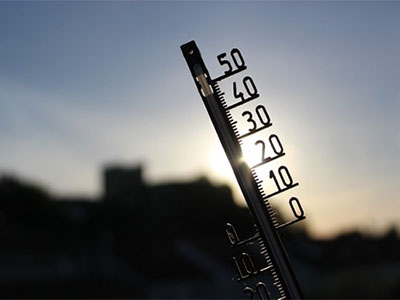Extreme temperatures and child heath

Why should we study effect of extreme temparture?
Climate change is increasing the intensity and frequency of extreme temperatures. Such changes challenge the body's adaptative abilities, especially among pregnant women and newborns. The body's thermoregulatory response to temperature variations requires adaptation of blood flow and maternal cardiac function, which can be detrimental to the fetus during pregnancy. Physiological changes have been observed in animals in response to extreme temparture, such as abnormal placental development with reduced blood flow or oxidative stress. In humans, a number of research studies suggest that exposure of expectant mothers to high or low ambient temperatures can affect pregnancy outcomes (premature birth, low birth weight, etc.). However, few studies have looked at the long-term risk, including child's respiratory function. The aim of this study was to analyze the associations between exposure to heat or cold during pregnancy and the first few weeks of life, and the respiratory function of the newborn.
How to measure temperature?
Exposure to ambient temperatures of pregnant women and their unborn children from the SEPAGES cohort was modeled at the home addresses, from the beginning of pregnancy to the first fourth week of infant's life. Various measurements carried out by healthcare professionals allowed to describe the respiratory function of newborns at six weeks after birth: tidal volume (volume of air inspired or exhaled during normal breathing), respiratory frequency (number of breaths per minute) and functional residual capacity (lung volume after normal exhalation). As fetal development and respiratory function differ according to sex, results were compared between females and males. The analyses also took into account other factors (possible medical history, breastfeeding, infant weight and height at examination, etc.).
What is the effect on temperature on respiratory health?
For boys, we did not observe any degradation of respiratory function associated with outdoor temperature during pregnancy. In females, exposure to high temperatures (e.g., a mean temperature of 24°C versus 12°C) between the second trimester of pregnancy and the fourth week of life was associated with a decrease in functional residual capacity and an increase in respiratory rate. Exposure to low temperatures (e.g., a mean temperature of 1°C versus 12°C) was associated with the same phenomena, as well as a decrease in tidal volume. In males, the analyses showed no association between early exposure to high or low temperatures and significant changes in respiratory function.
Conclusion
This study suggests that exposure to high or low temperatures from the earliest stages of life could have an impact on the development of the lung volume, particularly in female newborns. These effects may be more likely for exposures occurring between the second trimester of pregnancy and the first month of life. However, the observed variations are not pathological, and do not currently allow us to predict future respiratory disorders. Further research is needed to determine whether these associations persist in older children, are associated with future diagnosed respiratory pathologies, or are reversible over time.
To go further: Ariane Guilbert, Ian Hough, Emie Seyve, Matthieu Rolland, Joane Quentin, Rémy Slama, Sarah Lyon-Caen, Itai Kloog, Sam Bayat, Valérie Siroux, Johanna Lepeule “Association of Prenatal and Postnatal Exposures to Warm or Cold Air Temperatures With Lung Function in Young Infants” JAMA Network Open 2023, March
Read the article